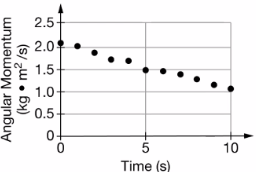In a carbonated drink dispenser, bubbles flow through a horizontal tube that gradually narrows in diameter. Assuming the change in height is negligible, which of the following best describes how the bubbles behave as they move from the wider section of the tube to the narrower section?
A pool cue ball, mass 0.7 kg, is traveling at 2 m/s when it collides head on with another ball, mass 0.5 kg, traveling in the opposite direction with a speed of 1.2 m/s. After the collision, the cue ball travels in the opposite direction at 0.3 m/s. What is the velocity of the other ball?
A block of weight \( W \) is pulled along a horizontal surface at constant speed by a force \( F \), which acts at an angle of \( \theta \) with the horizontal. The normal force exerted on the block by the surface has magnitude:
An object is dropped from the top of a 45 m tall building
Consider a solid uniform sphere of radius R and mass M rolling without slipping. Which form of its kinetic energy is larger, translational or rotational?
A disk increases from 2 complete revolutions in 2 seconds to 5 complete revolutions in 2 seconds. What is its average angular acceleration?
A meter stick of mass 200 grams is balanced at the 40-cm mark when a 100-gram mass is suspended from the 10-cm mark. What is the distance from the pivot point to the center of mass of the meter stick? Give your answer in centimeters.

During the experiment, students collect data about the angular momentum of a rigid, uniform spinning wheel about an axle as a function of time, which was used to create the graph that is shown. A frictional torque is exerted on the wheel. A student makes the following statement about the data. “The frictional torque exerted on the wheel is independent of the wheel’s angular speed.” Does the data from the graph support the student’s statement? Justify your selection.
Diamond has a density of \( 3500 \) \( \text{kg/m}^3 \). During a physics lab, a diamond drops out of Virginia’s necklace and falls into her graduated cylinder filled with \( 5.00 \times 10^{-5} \) \( \text{m}^3 \) of water. This causes the water level to rise to the \( 5.05 \times 10^{-5} \) \( \text{m}^3 \) mark. What is the mass of Virginia’s diamond?
A car can decelerate at \( -3.80 \, \text{m/s}^2 \) without skidding when coming to rest on a level road. What would its deceleration be if the road is inclined at \( 9.3^\circ \) and the car moves uphill? Assume the same static friction coefficient.
When a horizontal force of \( 4.5 \, \text{N} \) acts on a block on a resistance-free surface, it produces an acceleration of \( 2.5 \, \text{m/s}^2 \). Suppose a second \( 4.0 \, \text{kg} \) block is dropped onto the first. What is the magnitude of the acceleration of the combination if the same force continues to act? Assume that the second block does not slide on the first block.

A simple pendulum oscillates with amplitude [katex]A[/katex] and period [katex]T[/katex], as represented on the graph above. Which option bests represents the magnitude of the pendulum’s velocity [katex]v[/katex] and acceleration [katex]a[/katex] at time [katex] \frac{T}{2} [/katex]?
By continuing you (1) agree to our Terms of Sale and Terms of Use and (2) consent to sharing your IP and browser information used by this site’s security protocols as outlined in our Privacy Policy.
Quick Start Guide
AP physics 1, AP C, honors and advanced physics students.
Quickly filter questions by units and more.


Here’s guide to using 5 UBQ filters.
GQ = general question, MCQ = multiple choice, FRQ = free response.


Click the check or bookmark button.
Now you’ll be able to see completed or bookmarked questions at a glance!
Answer keys, personalized for you.

Phy will be responsible for grading your FRQs and GQs.
No more copy and pasting. Just solve and snap.
Questions for Mastery

By continuing you agree to nerd-notes.com Terms of Service, Privacy Policy, and our usage of user data.